Head of a young boy (Gaius Fulvius Plautius Hortensianus ?)
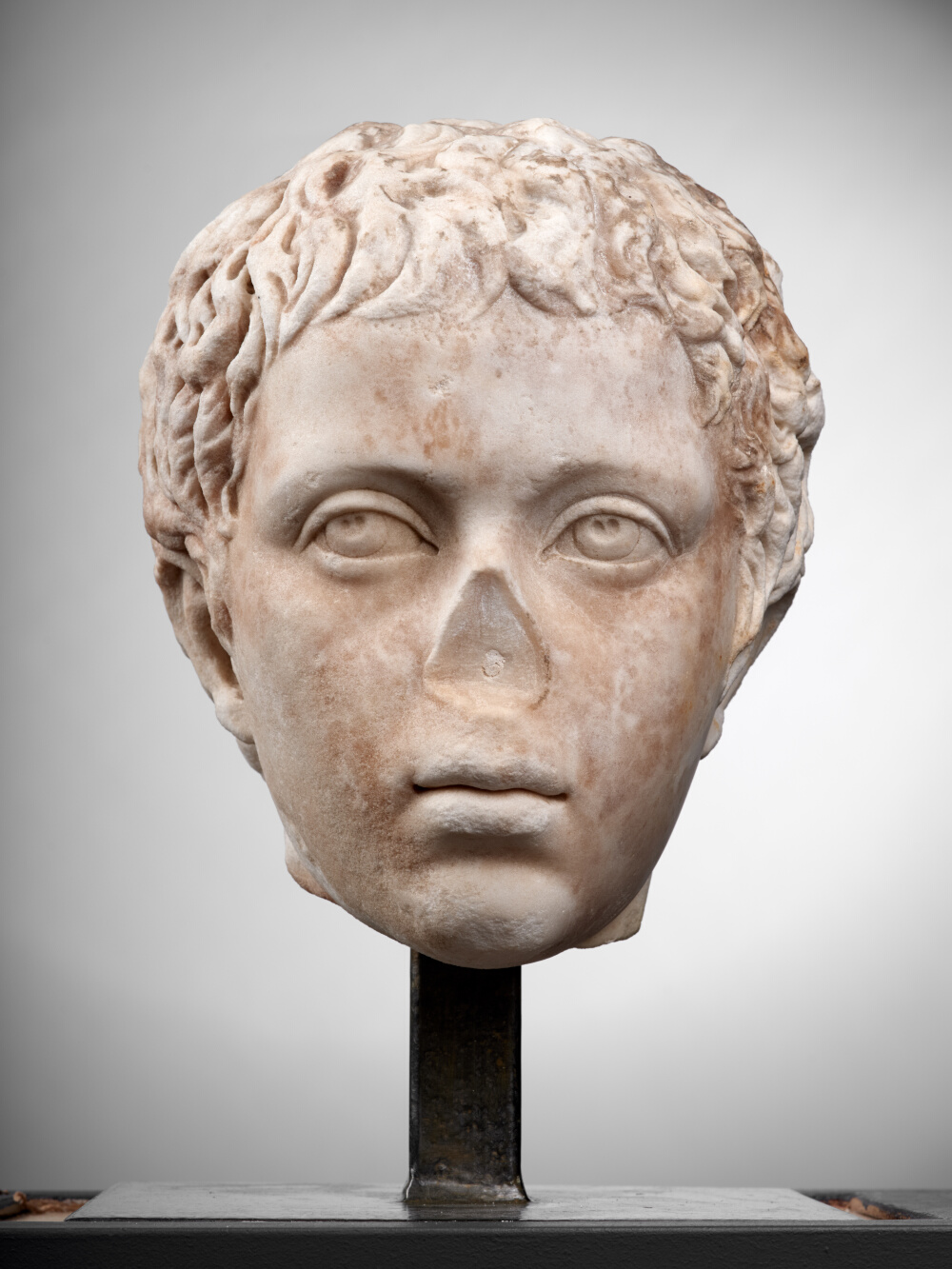
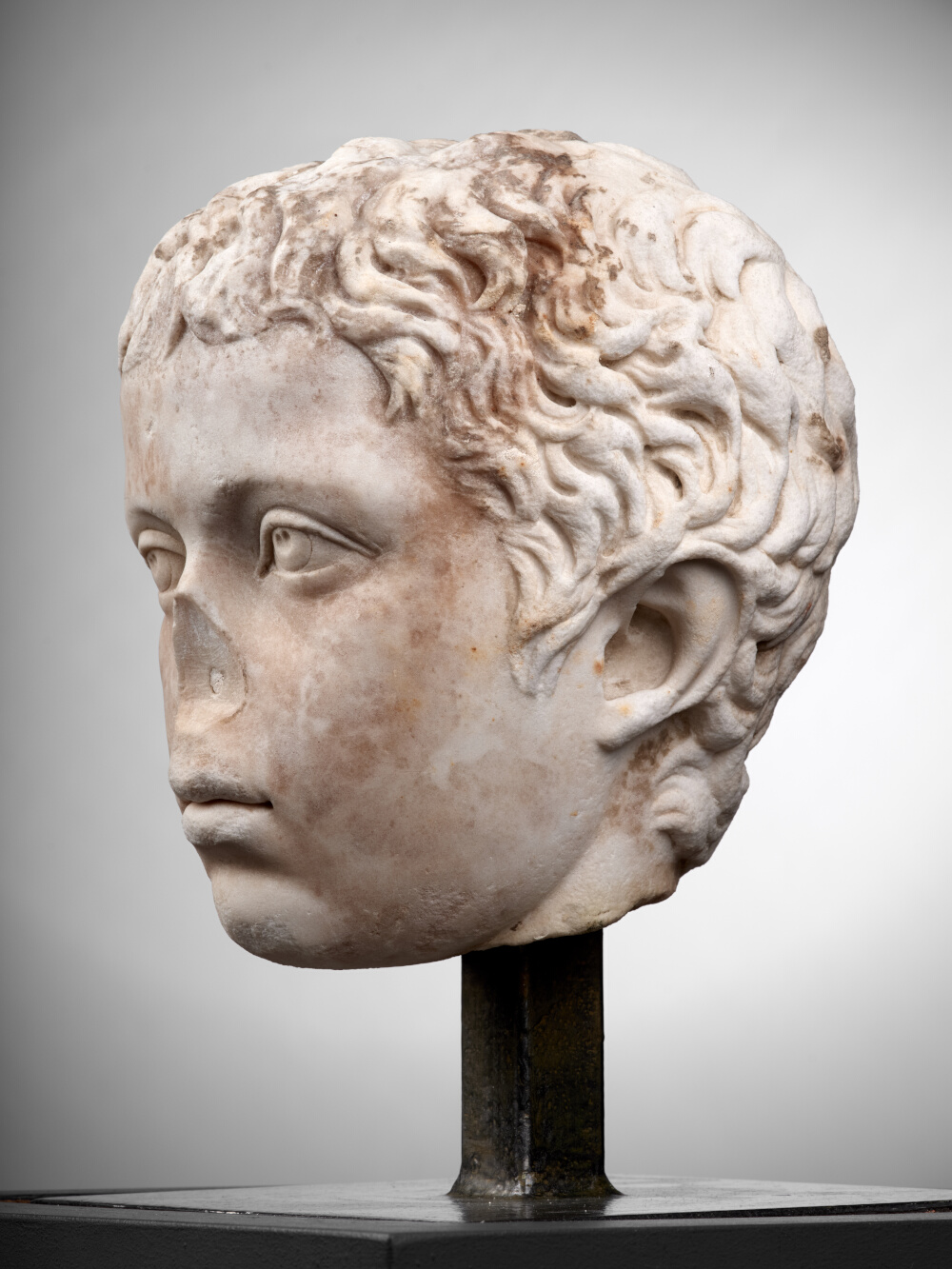
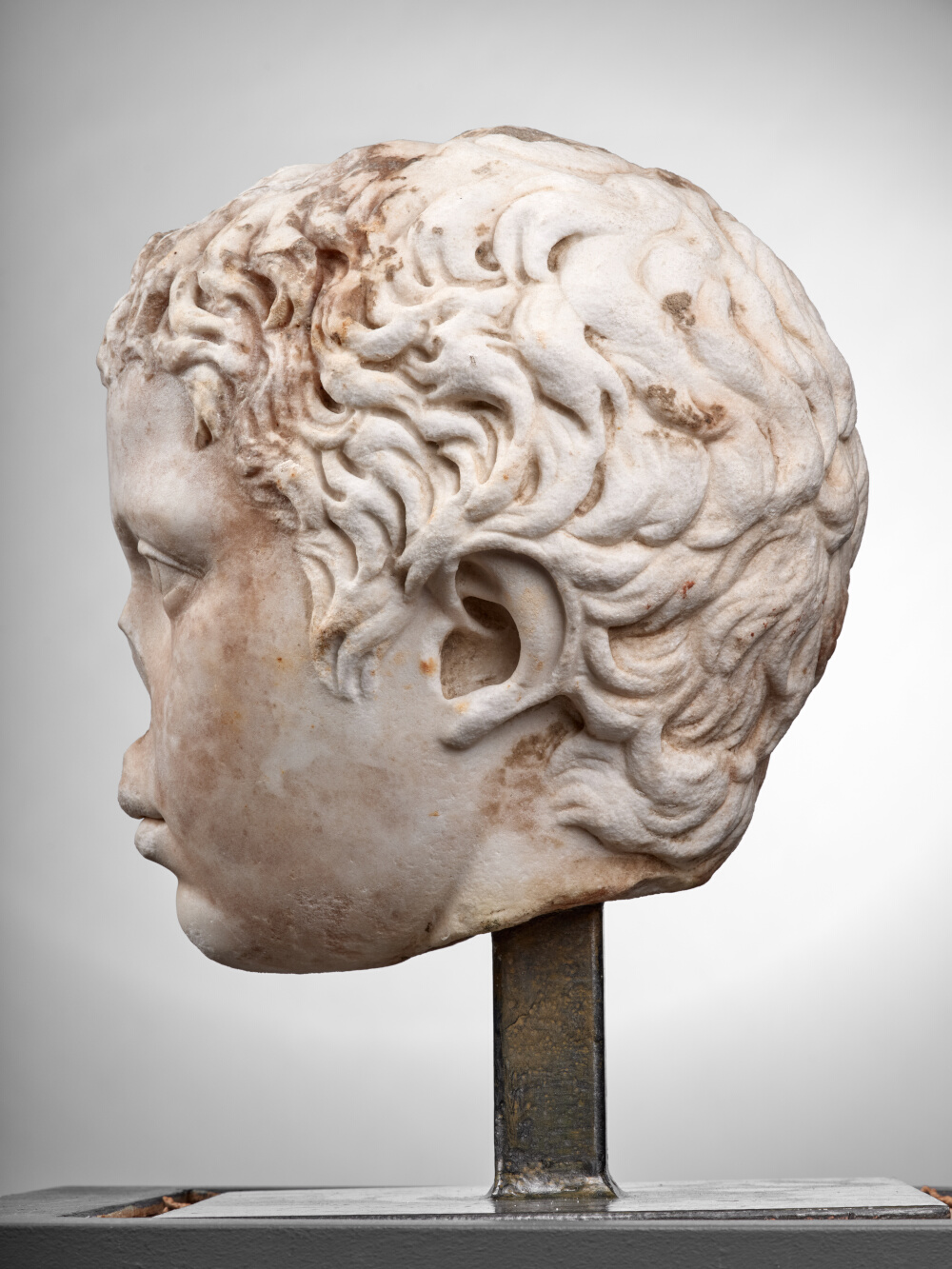
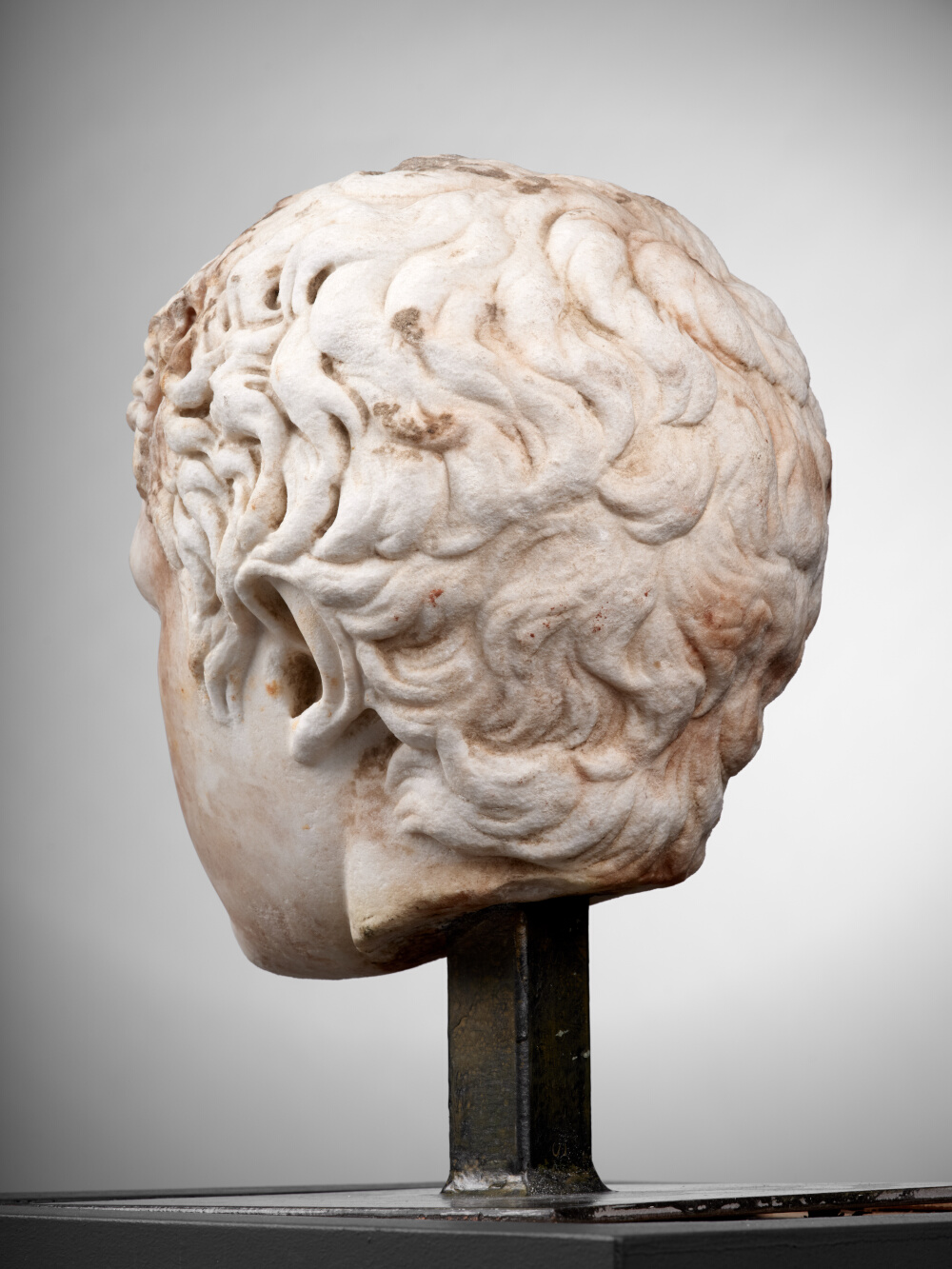
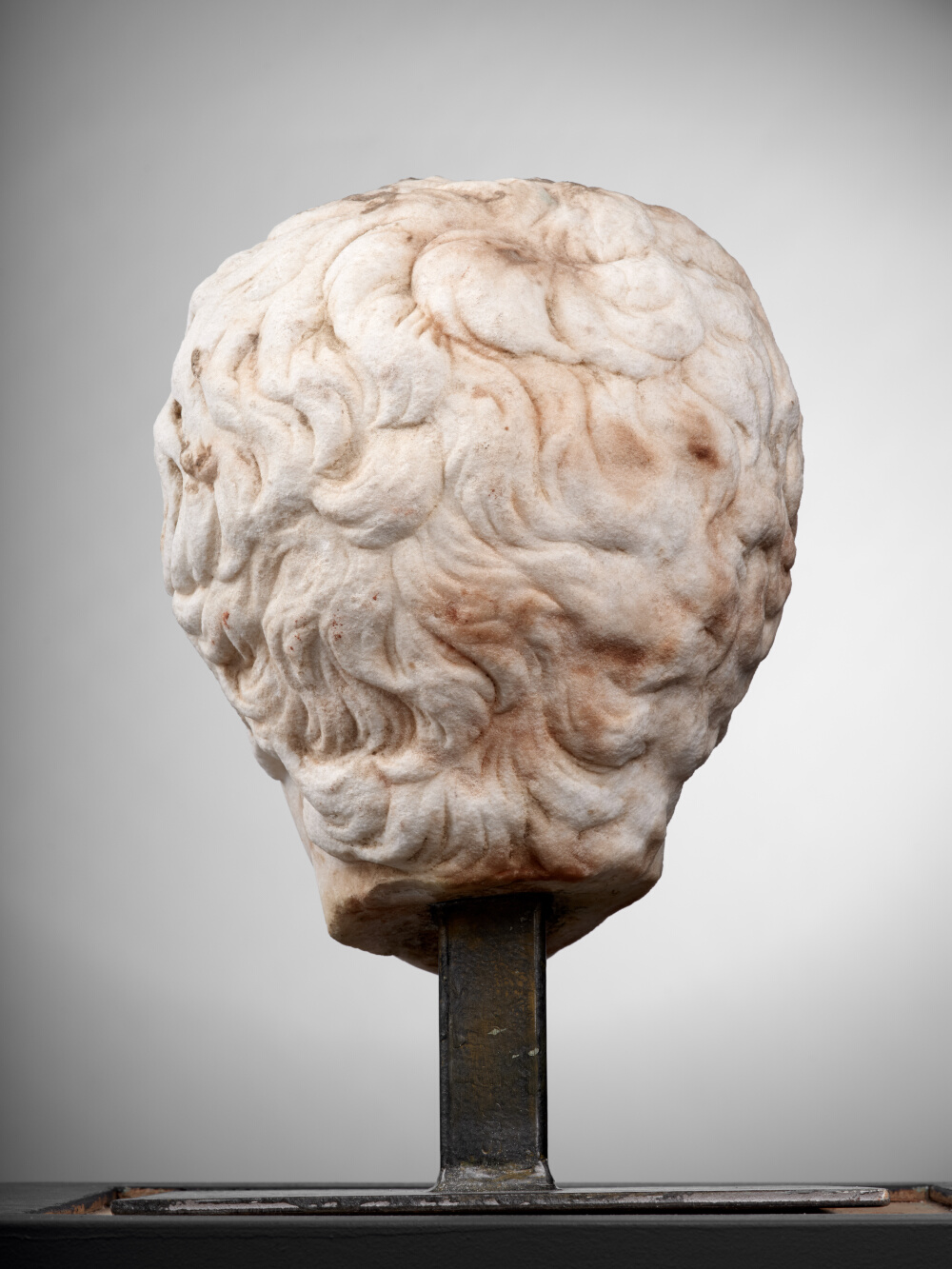
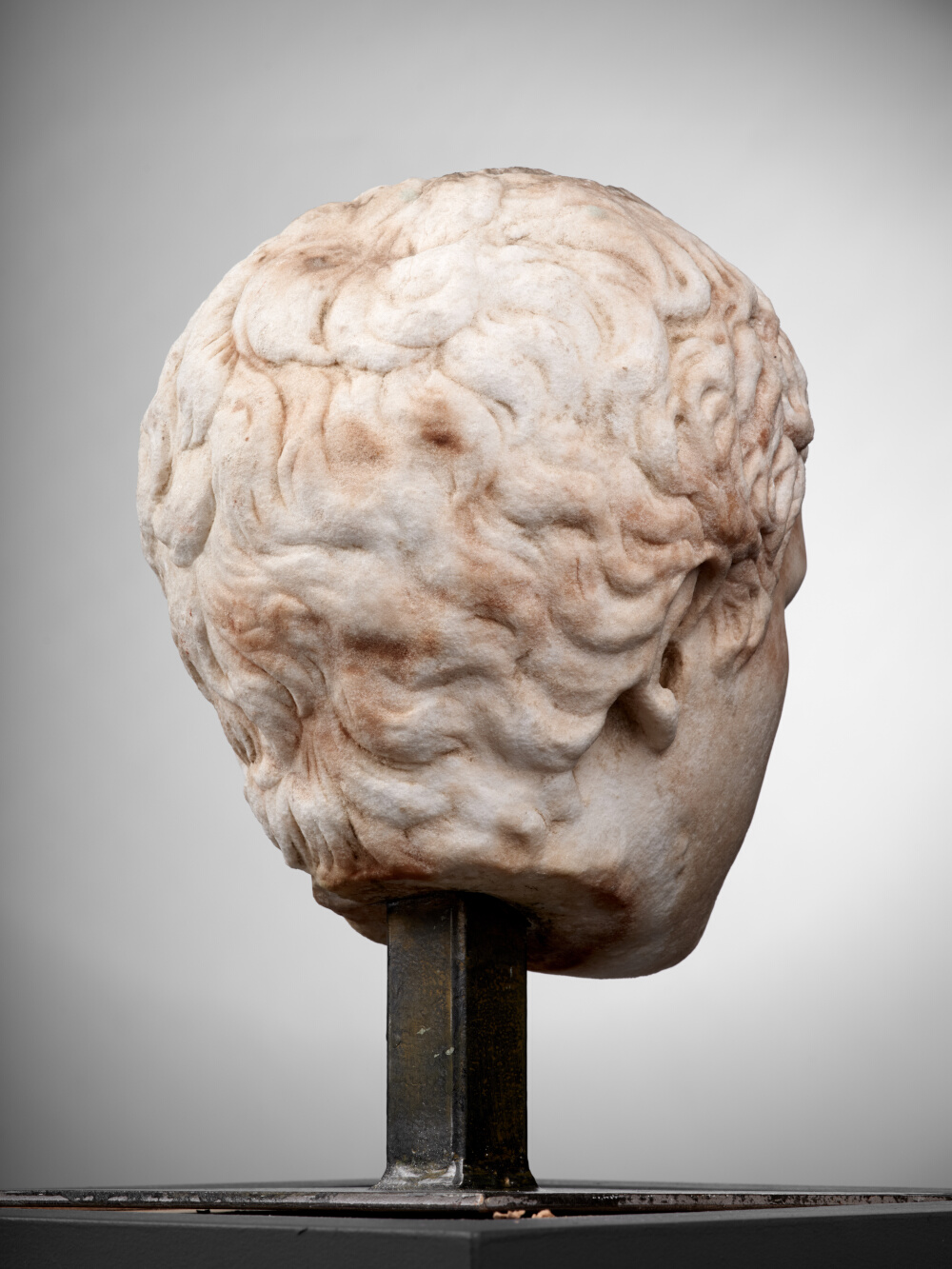
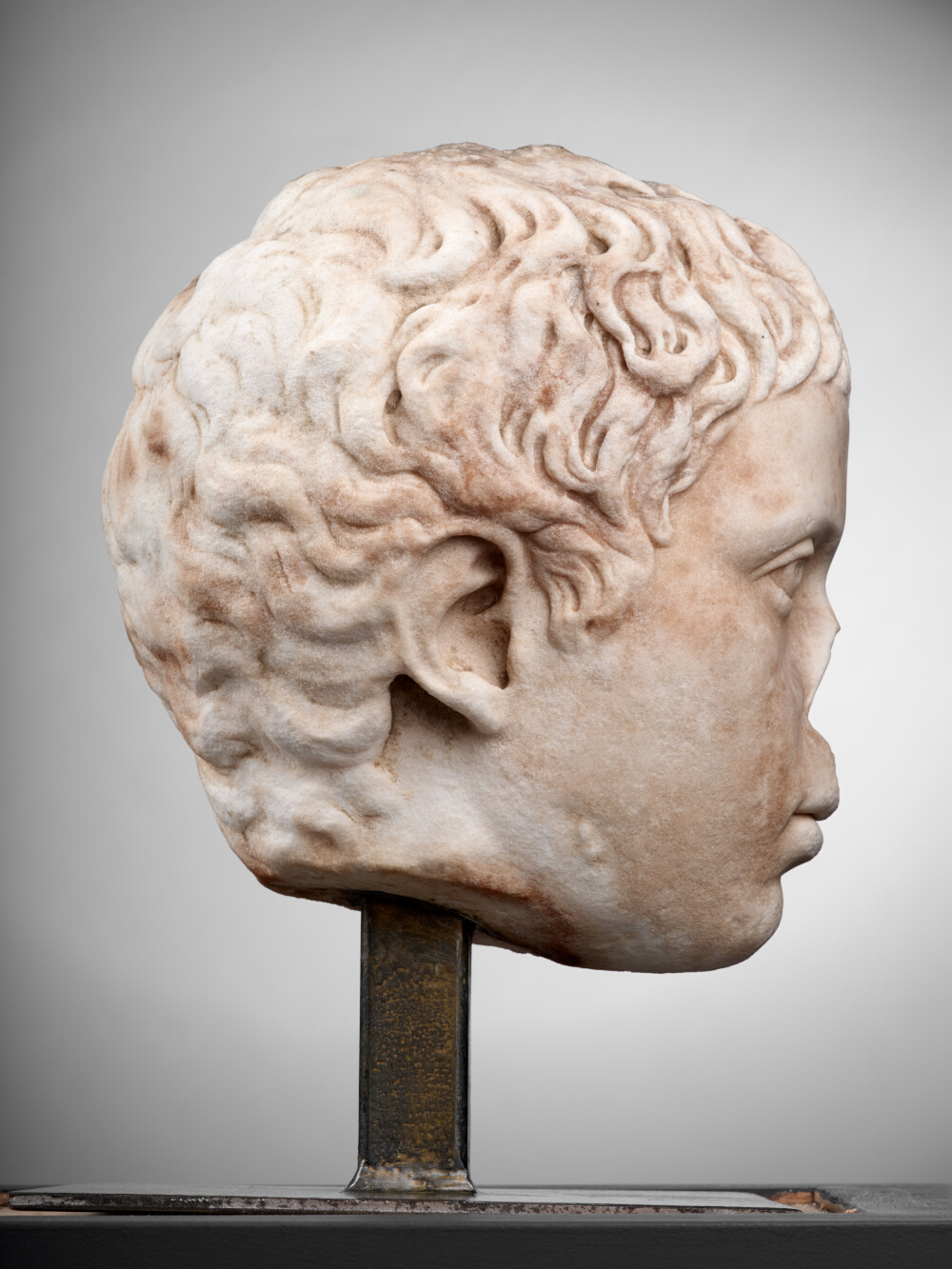
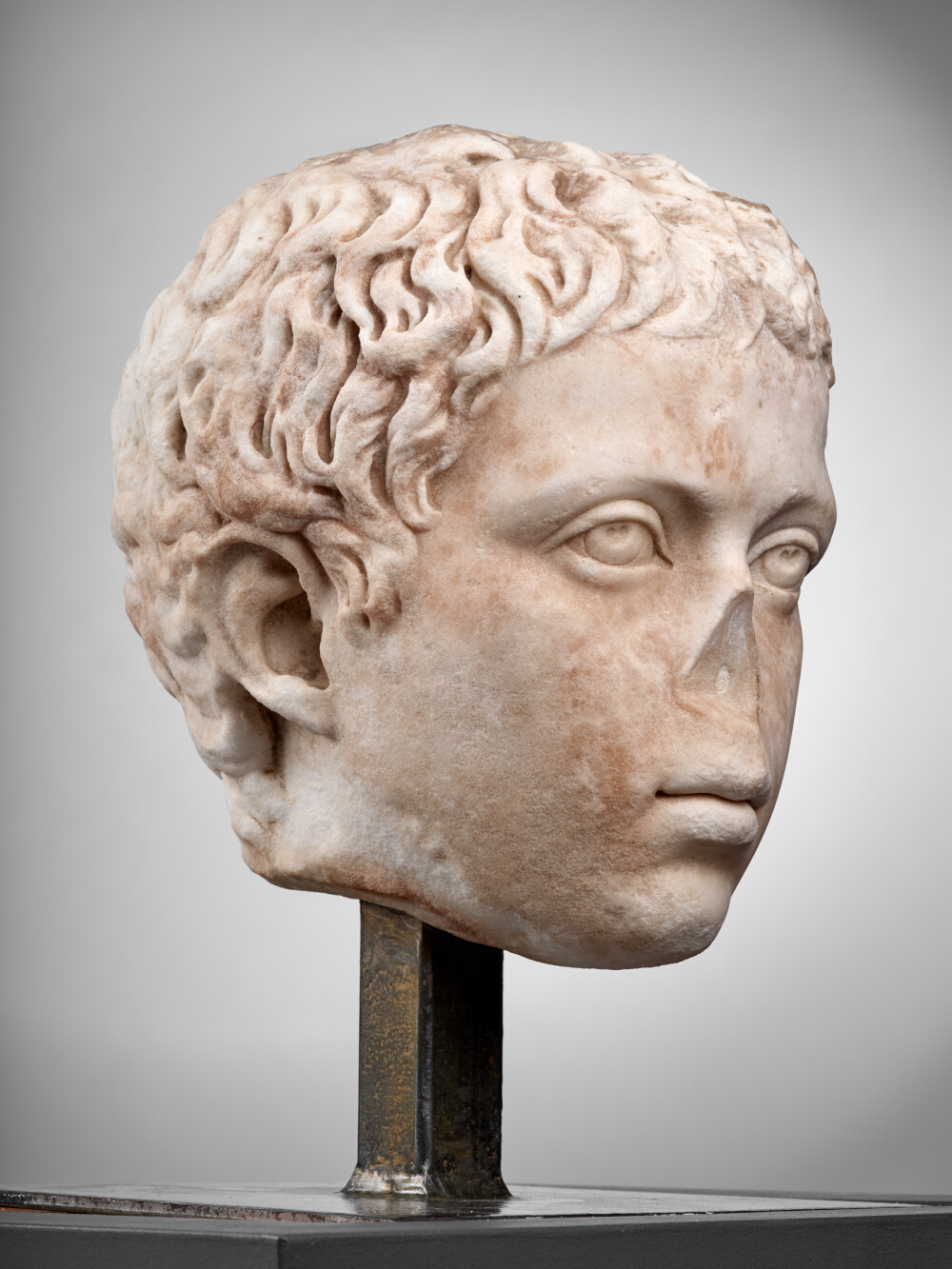
- Date de création
- Between 202 and 205
- Material
- Marble
- Dimensions
- H. 21 x l. 18 x P. 21 (cm)
- Inventory number
- Ra 68 (1)
- Photo credits
- Daniel Martin
The manner in which this lovely melancholy portrait has been rendered is proof of the sculptor’s great dexterity in his portrayal of the hair and almond-shaped eyes, with the shadows beneath them. The head has a receding chin, a sulky mouth, and hair brushed down from the top of the skull towards the ears and forehead to form a rather flat hairstyle composed of independent wavy strands, especially on the sides. While this clue may still point to hairstyles that were popular during the Antonine dynasty, it is nevertheless still found in portraits of Septimius Severus and the young Caracalla.
A 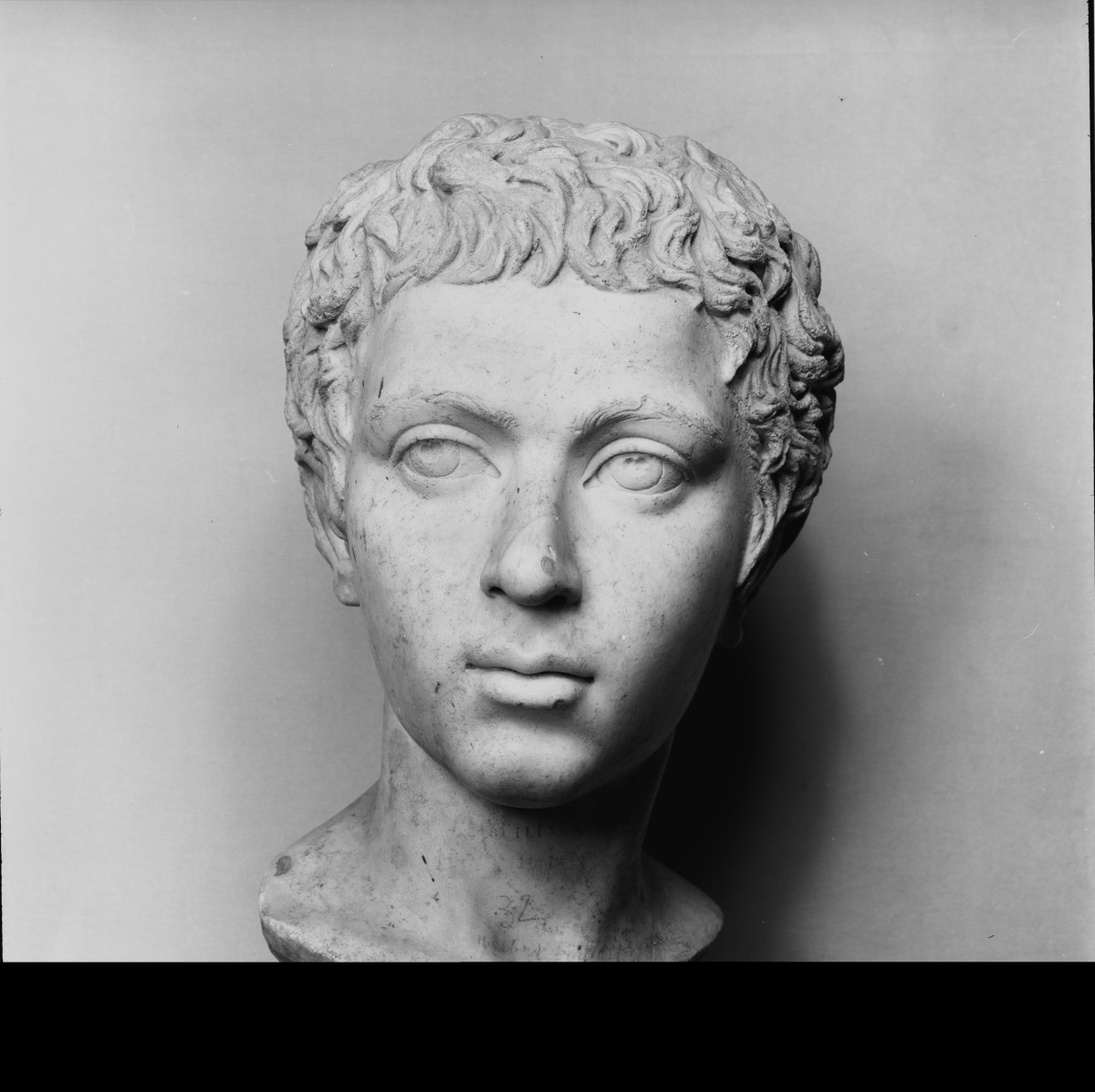 second head of the same type is kept in the Capitoline Museums in Rome. These two specimens of the same iconographic type having been discovered in two different places in the Empire, it seemed logical to assume that this is not the son of a rich citizen but that of a prince. Since the early images of Princes Caracalla and Geta are known to us, for a long time only Pertinax Caesar was seen as a credible candidate for this portrait K. Fittschen, P. Zanker, Katalog der römischen Porträts in den Capitolinischen Museen und den anderen kommunalen Sammlungen der Stadt Rom, Mainz, 1985, no 79, p. 90, pl. 95-96 ; K. Fittschen, Prinzenbildnisse antoninischer Zeit (Beiträge zur Erschliessung hellenistischer und kaiserzeitlicher Skulptur und Architektur), Mainz, 1999, pp. 75-76.. As the son of Pertinax, himself successor to Commodus, Pertinax the Younger assumed the role of Caesar and princeps iuventutis in 193, less than a hundred days before his father was assassinated after reigning for only three months. He himself suffered the wrath of the angry Caracalla, who had him put to death in 212 or 213. Pertinax the Younger and his mother, Flavia Titiana, received no honours or titles, and were not represented on the coins that circulated in Rome, although they did figure on a few that were minted in Alexandria.
second head of the same type is kept in the Capitoline Museums in Rome. These two specimens of the same iconographic type having been discovered in two different places in the Empire, it seemed logical to assume that this is not the son of a rich citizen but that of a prince. Since the early images of Princes Caracalla and Geta are known to us, for a long time only Pertinax Caesar was seen as a credible candidate for this portrait K. Fittschen, P. Zanker, Katalog der römischen Porträts in den Capitolinischen Museen und den anderen kommunalen Sammlungen der Stadt Rom, Mainz, 1985, no 79, p. 90, pl. 95-96 ; K. Fittschen, Prinzenbildnisse antoninischer Zeit (Beiträge zur Erschliessung hellenistischer und kaiserzeitlicher Skulptur und Architektur), Mainz, 1999, pp. 75-76.. As the son of Pertinax, himself successor to Commodus, Pertinax the Younger assumed the role of Caesar and princeps iuventutis in 193, less than a hundred days before his father was assassinated after reigning for only three months. He himself suffered the wrath of the angry Caracalla, who had him put to death in 212 or 213. Pertinax the Younger and his mother, Flavia Titiana, received no honours or titles, and were not represented on the coins that circulated in Rome, although they did figure on a few that were minted in Alexandria.
It is therefore unlikely that this lovely head unearthed in Chiragan is that of Pertinax the Younger. It would seem more plausible to assume that it is the head of Gaius Fulvius Plautius Hortensianus, son of Plautianus, the Praetorian prefect, and friend of Septimius Severus. The latter two shared a common origin in Africa (both were probably born in Leptis Magna) and may even have belonged to the same family. (?). They engaged and subsequently married their two children Caracalla and Plautilla in 202, both then fourteen years of age. The years 202-205, during which the two families were united by their children’s marriage could allow us to date the design of the portrait of Gaius Fulvius Plautius the Younger. An inscription in Timgad, which can also only date from this period, states that he bore the title of clarissimus puer, which unquestionably refers to a teenager under the age of 17 who has not yet taken to wearing the toga virilis. Having been exiled with his sister to the Aeolian Islands (or Sicily, according to sources) in 205, he was put to death there by Caracalla in 212.
This work represents a key part of the series of portraits from the early 3rd century, introducing stylistic characteristics that are particular to the Severan dynasty. Very similar to the images of Caracalla and Geta, and inspired, as they were, by those of the young princes of the Antonine dynasty to which Severus claimed to belong, these « Capitole - Toulouse » type portraits of teenagers are also those of a whole generation.
According to J.-C. Balty 2020, Les Portraits Romains : L’époque des Sévères, Toulouse, p. 161-168.
Bibliography
- Balty, Cazes 2021 J.-C. Balty, D. Cazes, Les portraits romains, 1 : L’époque des Sévères, 1.3 (Sculptures antiques de Chiragan (Martres-Tolosane), Toulouse. p. 17-20, 161-168, fig. 9, 10
- Cazes et al. 1999 D. Cazes, E. Ugaglia, V. Geneviève, L. Mouysset, J.-C. Arramond, Q. Cazes, Le Musée Saint-Raymond : musée des Antiques de Toulouse, Toulouse-Paris. p. 132
- Clarac 1841 F. Clarac, Musée de sculpture antique et moderne ou Description historique et graphique du Louvre et de toutes ses parties : des statues, bustes, bas-reliefs et inscriptions du Musée royal des Antiques et des Tuileries, et de plus de 2500 statues antiques … tirées des principaux musées et des diverses collections de l’Europe… accompagnée d’une iconographie égyptienne, grecque et romaine…. Tome II, Paris. p. 581
- Du Mège 1835 A. Du Mège, Description du musée des Antiques de Toulouse, Toulouse. no 216
- Du Mège 1828 A. Du Mège, Notice des monumens antiques et des objets de sculpture moderne conservés dans le musée de Toulouse, Toulouse. no 134
- Espérandieu 1908 É. Espérandieu, Recueil général des bas-reliefs de la Gaule romaine, 2. Aquitaine, Paris. no 1002
- Fittschen 1999 K. Fittschen, Prinzenbildnisse antoninischer Zeit (Beiträge zur Erschliessung hellenistischer und kaiserzeitlicher Skulptur und Architektur), Mainz. p. 75-77, pl.
- Fittschen 1978 K. Fittschen, « Review of " Das römische Herrscherbild, 3.1. Caracalla, Geta, Plautilla, Macrinus bis Balbinus,’ » Göttingische Gelehrte Anzeigen, 250, pp. 133–153. p. 147, no 5
- Fittschen, Zanker 1985 K. Fittschen, P. Zanker, Katalog der römischen Porträts in den Capitolinischen Museen und den anderen kommunalen Sammlungen der Stadt Rom, Mainz. p. 90, no 79, pl. 95-6
- Hausmann 1981 U. Hausmann, « Zur Typologie und Ideologie des Augustus-porträts, » Aufstieg und Niedergang der römischen Welt, Berlin-New York. p. 147, no 5
- Joulin 1901 L. Joulin, Les établissements gallo-romains de la plaine de Martres-Tolosane, Paris. no 284
- Rachou 1912 H. Rachou, Catalogue des collections de sculpture et d’épigraphie du musée de Toulouse, Toulouse. no 68
- Roschach 1892 E. Roschach, Catalogue des musées archéologiques de la ville de Toulouse : Musée des Augustins, Musée Saint-Raymond, Toulouse. no 68
- Roschach 1865 E. Roschach, Catalogue des antiquités et des objets d’art, Toulouse. no 68
- Rosso 2006 E. Rosso, L’image de l’empereur en Gaule romaine : portraits et inscriptions (Archéologie et histoire de l’art), Paris. p. 467-468, no 224
- Wiggers, Wegner 1971 H.B. Wiggers, M. Wegner, Caracalla, Geta Plautilla (Das römische Herrscherbild. 3. Abt), Berlin. p. 110
To cite this notice
Capus P., "Head of a young boy (Gaius Fulvius Plautius Hortensianus ?)", in The sculptures of the roman villa of Chiragan, Toulouse, 2019, online <https://villachiragan.saintraymond.toulouse.fr/en/ark:/87276/a_ra_68_1>.